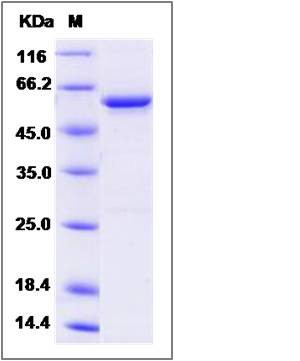Mouse GAD65 / GAD2 Protein
6330404F12Rik,GAD(65),Gad-2,GAD65
- 100ug (NPP3333) Please inquiry
| Catalog Number | P50653-MNCB |
|---|---|
| Organism Species | Mouse |
| Host | Baculovirus-Insect Cells |
| Synonyms | 6330404F12Rik,GAD(65),Gad-2,GAD65 |
| Molecular Weight | The recombinant mouse GAD2 consists of 587 amino acids and predicts a molecular mass of 65.4 KDa. It migrates as an approximately 58 KDa band in SDS-PAGE under reducing conditions. |
| predicted N | Gly |
| SDS-PAGE |  |
| Purity | > 90 % as determined by SDS-PAGE |
| Protein Construction | A DNA sequence encoding the mouse GAD2 (NP_032104.2) (Met 1-Leu 585) was expressed and purified with two additional amino acids (Gly & Pro ) at the N-terminus. |
| Bio-activity | |
| Research Area | Immunology |Signal Transduction |Metabolism |Pathways and Processes |Metabolic signaling pathways |Amino acid metabolism | |
| Formulation | Lyophilized from sterile 50mM Tris, 100mM NaCl, 10% gly, 3mM DTT, pH 8.0. 1. Normally 5 % - 8 % trehalose and mannitol are added as protectants before lyophilization. Specific concentrations are included in the hardcopy of COA. |
| Background | Mouse glutamate decarboxylase 2, also known as glutamate decarboxylase 65 kDa isoform, 65 kDa glutamic acid decarboxylase, GAD2 and GAD65, is a member of the group II decarboxylase family. GAD2 is identified as a major autoantigen in insulin-dependent diabetes. GAD2 is responsible for catalyzing the production of gamma-aminobutyric acid from L-glutamic acid. A pathogenic role for this enzyme has been identified in the human pancreas since it has been identified as an autoantibody and an autoreactive T cell target in insulin-dependent diabetes. GAD2 may also play a role in the stiff man syndrome. GAD2 is implicated in the formation of the gamma-aminobutyric acid (GABA), a neurotransmitter involved in the regulation of food intake. GABA is synthesized in brain by two isoforms of glutamic acid decarboxylase (Gad), GAD1 and GAD2. GAD1 provides most of the GABA in brain, but GAD2 can be rapidly activated in times of high GABA demand. Mice lacking GAD2 are viable whereas deletion of GAD1 is lethal. Deletion of GAD2 increased ethanol palatability and intake and slightly reduced the severity of ethanol-induced withdrawal. |
| Reference |
